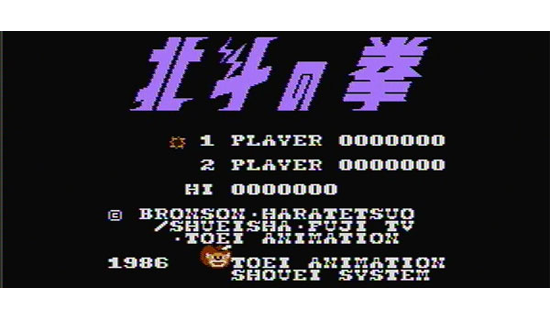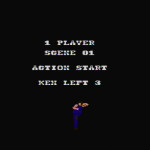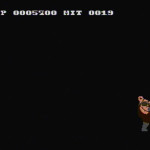Not even one month after the very first Hokuto no Ken game on the Sega Master System/Mark III came the first series installment on the Famicom/NES. Those who are knowledgeable on the history of the NES or Hokuto no Ken games may know that a game was released outside of Japan as “Fist of the Northstar”, however it was not this game. That release corresponds to Japan’s Hokuto no Ken 2 on the Famicom. The Master System/Mark III game its faults and oddities, but was a fairly good side-scrolling beat-em-up game at the time, and generally was a credit to its source material. Hokuto no Ken on the Famicom is the opposite of all of these things.
This is noticeable as early as the title screen: Sega’s Mark III game featured a very impressive rendering of our hero Kenshiro, but the Famicom game features only a logo. However, we certainly can’t fault a third-party developed game for not having as much care put into it as Sega usually did with their titles. When you start the game it’s immediately obvious that this a side-scrolling beat-em-up game as well. But more obvious is that the graphics are inexcusably bad for a Famicom title released in mid-1986. The game actually looks like it could be playing on an Atari 2600! The character sprites are utterly lacking in detail, and the colors of the backgrounds often make for a very dark and bleeding picture that’s difficult to see even on a standard CRT TV. Though not nearly as egregious of a crime as the graphics, the music and sound effects are also very uninspired, particularly when compared to the previous game on the Mark III.
Putting graphics and sound aside though, Hokuto no Ken could have still been saved by being a beat-em-up that played well and had some interesting design ideas. There isn’t necessarily anything wrong with the way it plays: You can punch, kick, duck, and jump extraordinarily high (which was the beat-em-standard set by Irem’s Spartan X in 1984). Additional moves can be added to your roster by collecting an item that is nothing more than three hiragana characters that read “abeshi” (a sound sometimes made by characters when being exploded to death due to Kenshiro’s attacks) to increase your number of stars. You obtain said item in a similarly obscure way to how you collected power-ups in the Mark III game: By defeating the pink-colored enemies with a punch, then jumping up to get the item as it appears. Obtaining a single star will allow you to not only jump even higher than before, but also to perform a jump kick. A second star will allow you to attack the projectiles thrown by enemies (and there are many of these) to reflect them back. Further stars have benefits such as increasing your movement and attack speed and allowing for an in-air punch. You also need at least one star in order for the 7 stars of Hokuto to appear. Jumping up and grabbing one of these will either refill your life bar or give you a 1-Up. This never helped me though, as I was never actually able to find them.
If you were good enough at the Mark III game, you probably could make it through without really knowing how to get any of the power-ups. In this game though, it may actually be impossible to do so due to the sheer amount of enemy projectiles being thrown at you by stage 3. Of course all of the game’s mechanics were detailed in the manual, but if you don’t have it (or access to the Internet, if you’re playing this in modern times) then you will probably never make it past the first stage. It’s a common misconception that the first level just goes on forever, with no way of progressing. This is an understandable thing to think, due to one extremely terrible design decision that thankfully did not become a trend in beat-em-ups: You have to know exactly which door to enter (by pressing Up, A and B simultaneously) to progress to the next area in each level. To be fair, you can only enter doors that Bart or Linn appear in. But unless you have the maximum of 7 stars, the door that they appear in could just be a deception, and end up being the wrong door! This essentially makes this game unplayable without a guide.
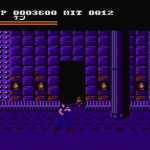 | 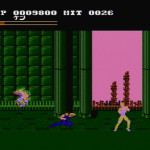 |
| Linn appears in door ways, deceiving you half the time. Also, looks at those colors bleed! | Some sharply dressed enemies in the second level… |
Whether by coincidence or by Toei mandate, this game also seems to use the idea that each boss should be beaten in the same way that they were in the source material. It may be possible to beat them without performing the proper moves (for example, kicking Heart in the chest several times to move his blubber away, and then rapidly punching him there for the finish), but at least early on in the game it isn’t recommended. Later on it actually is, since the special conditions are a bit hard to achieve given the difficulty of those bosses. In the only credit that I will give this title over its Mark III predecessor, the way in which the enemies pulsate slightly before they explode is much more true to the source material. Though the graphics themselves are terrible, so it really doesn’t matter.
 |  |
| Kenshiro takes down the second level boss, Shin. | And third level boss Jagi takes down Kenshiro! I never managed to make it past him… |
It’s very disappointing that this title sold over one million copies when it was so inferior to the Mark III Hokuto no Ken game. This was undoubtedly due to the fact that this was released in the heyday of the Famicom, so it’s very likely that a game in any popular franchise on the Famicom would have sold similarly. Despite that impressive number, it’s in no way worth going back to play when the Mark III game is superior and more accessible (given that this Famicom game was never released for download on any Virtual Console services). They both even cover the exact same story arc, for those who care about that. The good news for the Hokuto no Ken game franchise is that this is arguably as bad as it gets.
